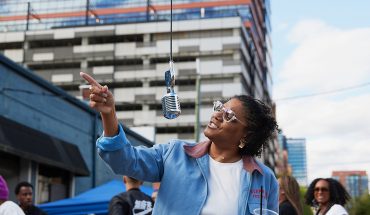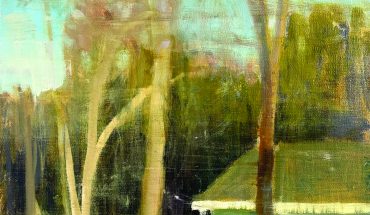
Exploris student Warren Gray delivers fresh kale to Ni Ni Myint, whose lack of access to healthy food inspired an award-winning project. Photograph by Sonja McKay
by Settle Monroe
A group of students and teachers from downtown Raleigh’s The Exploris School recently set out on a simple mission – to be the change they wanted to see in the world. They kept their focus local, and worked as a team to help Burmese refugees living in Raleigh. What they didn’t know was that their work here at home would gain them recognition on a world stage.
The team of 18 fourth and fifth graders were participants in a global program called Design for Change that teaches children how to impact their communities for the better. They started by researching problems plaguing their community. When they learned of a nearby neighborhood with refugees in need of fresh produce, they knew they had found their cause.
Their solution was so impressive, and so simple and replicable, that it was recognized as the top Design for Change project in the nation. Last December, three of the students on the Exploris team and four of their teachers traveled to Beijing, China to represent the United States and present the project to teams from 40 countries at the worldwide Be the Change conference.
“We didn’t know we would get to go to China when we started helping the refugees,” says fifth-grade student Addie Furr. “But it is really cool that it worked out like it did. The best part was seeing how children all across the world were doing small things to make a difference.”
The worldwide program is structured to guide students to address problems and devise solutions through four steps. The first encourages students to empathize with people facing a problem. The second step has them imagine what the problem’s solution could be; the third is to do something about it; and the fourth is to share that solution. Amanda Northrup, a fourth-and-fifth-grade teacher, spent weeks teaching her students how to conduct interviews during the first stage so they could better understand the people at hand and problems they face.
When the students interviewed Ni Ni Myint, a 30-year-old wife, mother, and Burmese refugee, they came prepared with researched background information and honed interviewing skills. “We really wanted Ni Ni’s story to drive the students’ actions,” Northrup says. “In order for that to happen, we spent a lot of time teaching the students how to ask thoughtful and informative questions. We had a panel of three students lead the interview, and the rest of the team took notes and followed up with probing questions.”
Northrup’s instruction paid off. Even with the language barrier, Myint says she immediately felt comfortable sharing her struggles and needs with the group. “The team was so nice,” Myint says. With her harrowing recent experience, that was vital. “My family was forced to leave my country because it was dangerous. We were very hungry in Burma. No one could help us there.”
Since arriving in the U.S. four years ago, though, Myint told the students she’d been living with chronic stomach pains and gastrointestinal problems. She’s not alone. Many refugees suffer from similar health problems when their diet changes from freshly harvested, local produce to highly processed foods in the United States.
The interviews left an impact on the students. Schuyler Pettibone, now a sixth-grader, says, “I always thought the problems the refugees faced took place when they were in their home countries, or on their way to the United States. After interviewing the refugees, I learned that they also face many problems once they arrive here.”
After interviewing Myint and other refugees, the students moved to the “imagine” stage of the process by brainstorming creative ways to provide fresh food for Myint and other refugees. No idea was too crazy or too small. Northrup led the students through a winnowing phase to determine feasibility. Eventually, they settled on their project. They would gather fresh produce from local farms and deliver the produce to Myint and her neighbors, also refugees.
After connecting with local farmers, the team spent an afternoon harvesting and bagging fresh kale. Fifth-grader Addie Furr says the experience was “awesome!” But actually delivering the fresh kale to Myint was her favorite part. “I will never forget the look on Ni Ni’s face when she opened the door and we were all there with fresh produce to help her feel better. That was just so cool.”
The students presented their project at the 2016 Scaling STEM conference in Raleigh as part of the program’s final stage, in which they share the results of their work. It was here that Design for Change USA director Sanjli Gidwaney heard their presentation. “Sanjli especially appreciated that the team listened carefully to the needs of the community and developed a targeted plan to meet that need,” says Exploris teacher and Design for Change leader Sonja McKay. “It is a simple project that anyone can replicate. Any volunteer can do this in an afternoon or a day.”
The global Design for Change leaders agreed with Gidwaney, naming Exploris’s work as the top project in the United States. Along with the award came the opportunity to attend the conference in Beijing.
“It was truly a once-in-a-lifetime experience,” says McKay. “The children were able to see how others across the world are taking simple steps to do good.”




